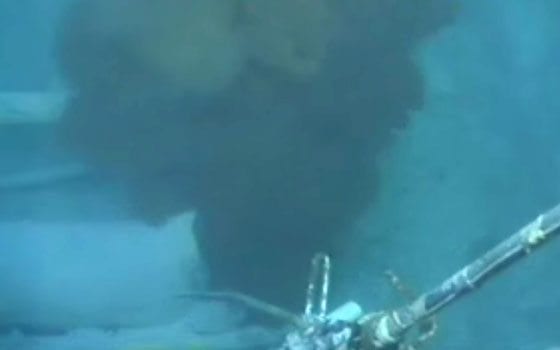

Author: AP /Evan VucciThis image made from video released by BP PLC shows the gushing oil well in the Gulf of Mexico on Sunday, May 30, 2010 at 9:32 a.m. EDT. Six weeks after the catastrophe began, oil giant BP is still casting about for at least a temporary fix to the spewing well underneath the Gulf of Mexico that’s fouling beaches, wildlife and marshland. A relief well that’s currently being drilled, which is supposed to be a better long-term solution, won’t be done for at least two months. That would be in the middle of the Atlantic hurricane season, which began Tuesday.
At nearly every step since the Deepwater Horizon exploded more than a month ago, causing the worst oil spill in U.S. history, rig operator BP PLC has downplayed the severity of the catastrophe in the Gulf of Mexico.
On almost every issue — the amount of gushing oil, the environmental impact, even how to stop the leak — BP’s statements have proven wrong. The erosion of the company’s credibility may prove as difficult to stop as the oil spewing from the sea floor.
“They keep making one mistake after another. That gives the impression that they’re hiding things,” said U.S. Sen. Bill Nelson, a Florida Democrat who has been critical of BP’s reluctance to publicly release videos of the underwater gusher. “These guys either do not have any sense of accountability to the public or they are Neanderthals when it comes to public relations.”
Take one of the most obvious questions since the April 20 explosion: How much oil is leaking? Official estimates have grown steadily — first the word was none, then it was 42,000 gallons per day, then 210,000 gallons. And now a team of scientists says the leak may well be five times that, making the spill worse than the 1989 Exxon Valdez disaster off the Alaska coast.
All the while, BP has been slow to acknowledge the leak was likely much worse than the public had been told.
The oil giant’s behavior has led to accusations that it has been motivated to keep the leak estimate low because under federal law the size of eventual fines is tied to the size of the leak.
Nelson said that he believes BP has delayed release of everything from the actual flow rate to the videos because of a federal law that allows the government to seek penalties of $1,000 to $4,300 per barrel (42 gallons) of oil spilled in U.S. waters.
“And so naturally they want to minimize what people were thinking they were going to spill,” he said.
High-end estimates by BP, the Coast Guard and the National Oceanic and Atmospheric Administration reached 588,000 gallons per day in late April, BP spokesman David Nicholas acknowledged Friday to The Associated Press after weeks of the company sticking with the lower estimate. But it wasn’t until last Thursday that officials conceded that the leak was considerably larger than the 210,000-gallon per day figure that had been floated as the best estimate for the prior four weeks.
With criticism continuing to mount, when he was pressed Friday about BP’s perceived lack of transparency, Chief Operating Officer Doug Suttles said: “We’re trying to provide as much data as we can. We’re in the middle of this operation. … There’s a tremendous amount of transparency here.”
Asked late Friday why BP had downplayed so many issues related to the spill and why BP had been wrong on so many other issues, Nicholas did not answer directly, saying, “This event is unprecedented; no company, no one, has ever had to attempt to deal with a situation such as this at depths such as this before. BP, the Unified Command, the federal authorities and the hundreds of companies and thousands of individuals engaged on this effort, are doing everything we can to bring it under control and make it good.”
Nicholas said only Friday that daily estimates from April 27 through April 30 were based on two scientific standards. The “low end” was always around 42,000 gallons per day, the “best guess” was between 210,000-252,000 gallons per day, and the “high end” varied from 504,000 to 588,000 gallons per day, he said.
The 210,000-gallon estimate that became the official talking point for weeks turned out to be wrong, too. A team of scientists from the government and academia said last Thursday that the leak is really spewing somewhere between 500,000 and a million gallons per day.
The new estimates were between 12 and 24 times greater than what was first offered, and instantly made the Deepwater Horizon spill the worst in U.S. history. Even using the low end of the estimates, nearly 18 million gallons have spilled so far. At the high end, the well could have gushed as many as 39 million gallons.
Even President Barack Obama has voiced his frustration, laying the blame squarely on BP for the often incorrect assessment of the spill’s size.
“Their interest may be to minimize the damage and, to the extent that they have better information than anybody else, to not be fully forthcoming,”
Obama told reporters last week, “So my attitude is, we have to verify whatever it is they say about the damage.”
Obama noted that BP kept video of the leak and didn’t make it public.
“At that point, BP already had a camera down there, but wasn’t fully forthcoming in terms of what did those pictures look like? And when you set it up in time-lapse photography, experts could then make a more accurate determination. The administration pushed them to release it,” Obama said. “But they should have pushed them sooner. But there was a lag of several weeks that I think, that I think shouldn’t have happened.”
BP’s Nicholas said the government “has had access to the video since the incident started.”
Perhaps if BP, one of the wealthiest companies in the world, had released the video to the public and independent experts, it would have led to more accurate assessments of the spill’s size early on.
“I’m disappointed in BP,” said Plaquemines, La., Parish President Billy Nungesser. “BP can’t see the forest through the trees.”
Nungesser said Friday that he hoped a meeting with Obama would result in the federal government giving BP more direction on how to save the state’s wetlands.
Then there are the attempts, unsuccessful so far, to stop the oil. Last Thursday, BP and federal officials said on morning TV talk shows that the so-called “top kill,” a procedure to pump heavy mud into its blown-out well in hopes of stopping the leak, was going well. Yet hours later, BP said the company had actually paused the procedure the night before. A spokesman told AP on Friday that stops and starts are normal, in part to analyze progress.
BP’s downplaying of the situation may have began with a phone call, some 16 hours after the rig exploded and killed 11 workers, leaving behind an inferno that burned for two days and has been leaking at least ever since the rig sank.
In a low-key tone, a man who identifies himself as BP employee Carlos Moreno notified Louisiana authorities that oil was unlikely to reach their shores. He emphasized that BP wanted to give a “heads up” about the sheen spotted floating near the crippled rig 50 miles off the Louisiana coast.
At first, the Coast Guard said there was no leak from the vast reservoir of oil more than a mile below the Gulf’s surface. Then, after analyzing images taken underwater by remote-controlled cameras, the Coast Guard estimated 42,000 gallons per day were leaking. A week after the explosion, that rose to 210,000 gallons.
“You’re never comfortable with estimating at the beginning of the oil spill,” Coast Guard Rear Admiral Mary Landry told AP.
The shift in spill estimates — and the other downplayed details from BP — have caused environmental activists like Lorraine Margeson of St. Petersburg, Fla., to question whether other details are being low-balled, as well. Margeson wonders if the numbers of dead animals and birds are being accurately reported by BP and other officials.
“From the get go, every aspect of the situation has been downplayed,” she said. “This thing has been out of control in terms of informing the public and transparency from day one.”
Associated Press






